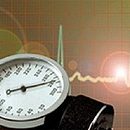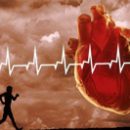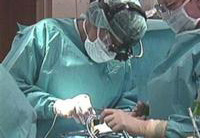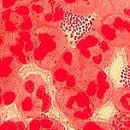ORVI - not at all such a harmless disease, which some people think it is. Still would! It is this young who can cause the development of your child myocarditis. All about this problem knows the author of this article.
Content
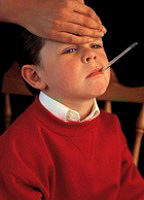 Indeed, children often complain about pain in the heart of imitation of adults. It is true that they are poorly localized pain, and often it turns out that it hurts in a completely different place, for example, in the area of the stomach.
Indeed, children often complain about pain in the heart of imitation of adults. It is true that they are poorly localized pain, and often it turns out that it hurts in a completely different place, for example, in the area of the stomach.
But the child may be sick. And, although cardiovascular diseases, children suffer less often than adults, the origins of many heart diseases of adults take the beginning in childhood.
Features of the cardiovascular system of the child make it sensitive to the most different external influences, and therefore any infectious disease in one way or another violates the functions of the heart and blood vessels. Especially often the heart suffers from ORVI, lung inflammation, dysentery. And almost inevitable - during diphtheria.
Of the three cordic wall shells are most sensitive to infectious agents myocardium - heart muscle. The toxins secreted by microbes damage muscle fibers and the connecting and intestine interlayers located between them. But little of this.
Under the influence of toxins, protein substances circulating in the blood are modified so much that the body begins to perceive them as alien. And alien, as you know, he always seeks to turn away, neutralize. The reaction occurs, which is usually completed by the inflammation of the heart muscle - myocarditis.
Children's myocarditis as a result of infectious disease
Myocarditis can develop even in full swing or even at the very beginning of the infectious disease, but very often its first signs are manifested only after three to four weeks, during the period when the child consider recovered.
With the easiest course of myocarditis, the temperature increases slightly or even remains normal. Disorders of well-being are expressed by nonresko, and the child, especially small, does not complain about. However, Mother may notice that he turned pale, became unfortunately tearful and capricious, playing, quickly gets tired, reluctantly runs, it is often sitting on, the stairs rises more slowly than usual, with shortness of breath. In such cases, it is necessary to advise with the doctor, examine the child.
With myocardet of medium severity, the symptoms of the disease become more explicit. Fucking lethargy, small mobility of a child, shortness of breath, occurring even with insignificant physical tension. Older children complain of heartbeat, «fading» Hearts, often and pain in the heart. Still sharply expressed all these signs when myocarditis takes place hard.
The outcome of the disease depends not only on the extent of its severity, but also whether the diagnosis was raised in a timely time, whether treatment was neatly carried out and, which was very significant, whether the designated regime was respected.
Light forms of myocarditis usually end in 3-4 weeks with complete recovery, although minor heart rhythm disorders may continue for a long time.
A prosperous outcome is observed and at myocardium of moderate severity. However, in some cases, the inflammatory process becomes more common, part of muscle fibers die, and in their place there is no longer muscle, but a connecting tissue, which is sealing over time, turning into inelastic and «Disabled» Rubbed fabric. It happens about the same thing that almost everyone had to observe when a dense scar remains after a wound or inflammation on the skin. If such foci in myocardium a little, they do not represent much danger. But when they begin to occupy large areas and it comes to sclerosation of the entire myocardium, the heart function is seriously hampered, and severe blood circulation disorders may develop. Most often, this is happening in cases where myocarditis proceeds hard or re-after the next infectious disease.
The inflammatory process in the heart muscle sometimes ends and so: cells cease to economically spend oxygen, the energy resources of myocardium are reduced, and as a result it weakens its contractility. In other words, myocardiodistrophy occurs, nutritional violation of the heart muscle. It is very important to prevent this. After all, changes in the heart muscle not only complicate the child's life, but also increase the risk of coronary heart disease already at the young age.
How to treat myocarditis in a child
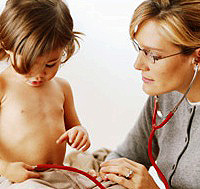 Most of all the difficulties arise, as experience showed, with the most, it would seem simple: compliance with the bed regime. While the child feels bad, he doesn't seek to get up, but as soon as he gets better, temptation arises to stand up, run around the room, ride in toys or books. And, meanwhile, it is necessary to lie - precisely so that more serious changes in the heart muscle do not develop.
Most of all the difficulties arise, as experience showed, with the most, it would seem simple: compliance with the bed regime. While the child feels bad, he doesn't seek to get up, but as soon as he gets better, temptation arises to stand up, run around the room, ride in toys or books. And, meanwhile, it is necessary to lie - precisely so that more serious changes in the heart muscle do not develop.
Children of younger give toys, senior - books, chess, drawing album, games that can be in bed.
When the improvement in cardiac activity comes, the doctor appoints therapeutic physical education. First, the exercises are done lying, then - sitting and finally - standing. The complex is gradually becoming more complicated; respiratory gymnastics is introduced into it. It is necessary to monitor the response to physical exertion. I advise parents to make a diary in which to record the morning (at 7 to 8 am, to breakfast) and evening (at 17 o'clock) temperature, pulse rate before and after physical education, other observations.
Mostly recovery of the child contributes to the right nutrition. To improve metabolic processes in the heart, magnesium and potassium salts are needed. Their suppliers can be cereal: buckwheat, Hercules, pearl, as well as baked potatoes, dry fruits, especially dried, prunes.
Vegetable vegetable fats - sunflower, olive, corn oil. They provide the energy of the heart, improve the state of cell membranes. Vegetable fats should be 1/3 of all fats that the child gets, but it is necessary to use them not for frying, but to refill ready-made dishes. Roasted better to avoid. Completely eliminated all the sharp and salty.
The need for vitamins, especially in ascorbic acid, in vitamins A, O, Groups in during the disease increases, since these vitamins are involved in metabolic processes occurring in myocardium. It is necessary to give the child to give greens (parsley, dill, cilantro), fruit, except hard (quince, hard pears), vegetables, except for too rich fiber and causing intestinal blown (white cabbage, beans, peas).
Of course, the child needs proteins, that is, meat and fish dishes, and absolutely necessary - kefir, milk, cottage cheese. It is necessary more often, but in small portions. Since in the morning appetite in such children is lowered and they eat little, after the first breakfast (at 8 to 9 hours), you should enter the second (at 11 to 12 hours).
As the functions of the cardiovascular system improve, the doctor allows the child to get up, walk around the room, and then walk. During this period, parents have many questions. Is it possible to run the child, play moving games, ride the stairs, physical education at school? Answer these questions unambiguously impossible. This is solved individually, depending on the well-being of the child and objective data recorded on the electrocardiogram.
The task of parents is to ensure that the child does not exceed the recommended activity limits, but did not reduce them, did not become a change, did not focus on his feelings.

